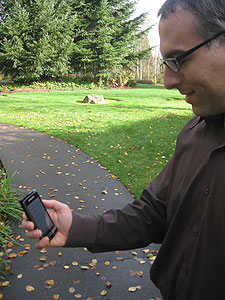REDMOND, Wash. — Nov. 16, 2010 — On any given day, millions of people around the world will take a few minutes to check their Outlook Mobile Inbox on a smartphone, especially while in transit or away from the office.
There may be something urgent that requires their immediate response, a meeting room location change, or a new calendar appointment waiting for attention. In any instance, the ability to check in via a smartphone helps them manage tasks and get on with the day while on the go.

Adam Glick, senior technical product manager for Microsoft Exchange Server, navigates his phone using Exchange ActiveSync.
For many, the convenience of accessing e-mail, calendar and contacts on a smartphone is integral to their business’ success, and they cannot imagine working without this capability.
The protocols that allow this mobile messaging to take place on smartphones reside in Microsoft Exchange ActiveSync (EAS), which has become the de-facto industry standard for mobile messaging synchronization.
EAS is an XML-based protocol that communicates over HTTP (or HTTPS) to synchronize e-mail, contacts, calendar, tasks and notes from a messaging server to a mobile device. The protocol also provides mobile device management and policy controls.
Many leading companies — including Apple, HP/Palm, HTC, Nokia, Samsung and Sony Ericsson — license EAS for use on smartphones and other mobile operating systems. Organizations around the world agree that EAS is a critical part of business today.
“Exchange is available everywhere today, through Outlook on the PC, Web Apps in the browser, and as Outlook Mobile on mobile phones,” says Adam Glick, senior technical product manager, Exchange Server at Microsoft. “Because 65 percent of businesses worldwide use Exchange Server for their e-mail and calendaring, the great thing is that almost every smartphone, even those on non-Microsoft platforms, can use Exchange wireless e-mail, right out of the box.”
“It’s important that we broadly license Exchange ActiveSync to other companies and competitors in the industry,” Glick says, “because it increases customer choice and helps people use Exchange across a wide range of devices.”
Data Protection and Smartphone Innovation
EAS does more than synchronize information: It allows organizations to protect the data on the devices that connect to their Exchange Server. Data can be protected though policies that enforce data encryption and require PIN passwords on devices, and EAS enables IT professionals to erase all data off a phone that has been lost or stolen.
Microsoft’s EAS licensing program also fuels continued innovation in the messaging server market and has licensed companies like Google for its Gmail server implementation. Like Google, the information technology-management software company SmarterTools Inc. licensed Exchange ActiveSync in 2009, allowing the company to extend EAS to more than 15 million customers through the latest version of its SmarterMail mail server.
The licensing agreement provides a patent license to SmarterTools for EAS, and allows Microsoft to expand its reach to SmarterTools’ customer base, which includes hosting and service providers, enterprises, and small and medium-sized businesses.
Microsoft has entered more than 700 licensing agreements with companies including Google, SmarterTools and others. These agreements underscore the value that intellectual property licensing offers in helping partners shorten their development cycles and increase their focus on customer-related innovation. Nonetheless, some companies such as MailSite and Communigate Systems opt not to license EAS for their messaging server products.
Global Crossing, a leading global IP solutions provider, plans to adopt EAS to reduce the cost of its employees’ mobile phone use. Right now, most Global Crossing staff use RIM BlackBerry devices to connect to their Exchange Server.
“We found that every mailbox with a BlackBerry connection to Exchange uses five times the amount of connection resources compared to a mailbox with Exchange ActiveSync,” says Steven Schafer, director of Collaboration and Network Services at Global Crossing. “So we’ll be switching to Exchange ActiveSync.”
Better Together: Windows Phone 7 and Exchange ActiveSync
Windows Phone 7 also supports EAS for synchronizing e-mail, calendar events and contacts with Exchange Server — or any other messaging service or server that supports EAS.
“Exchange ActiveSync is native to Windows Phone 7, allowing people to set up and access multiple e-mail accounts and calendars on their phone,” says Glick.
Windows Phone 7 and Exchange will enable business workers to use the complete suite of Microsoft products on the go, allowing for deep integration with a company’s infrastructure and application policies.
“We’re always aiming to understand productivity better than any other company, and to exceed our customers’ expectations on the smartphone. This is a pivotal moment in mobile phone technology history, with the innovation coming to market with Exchange ActiveSync, smartphone manufacturers and customers are the productivity winners.”




